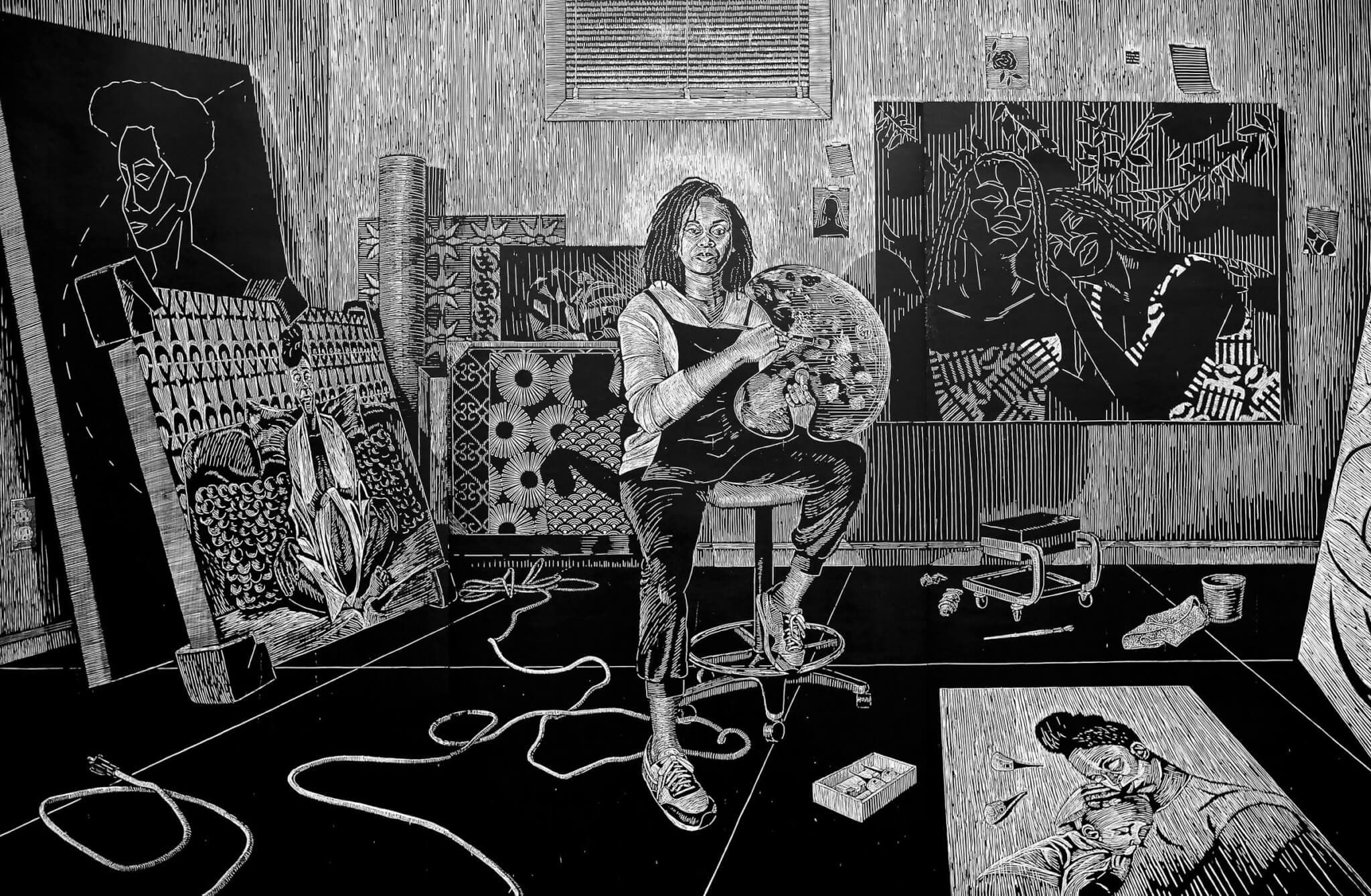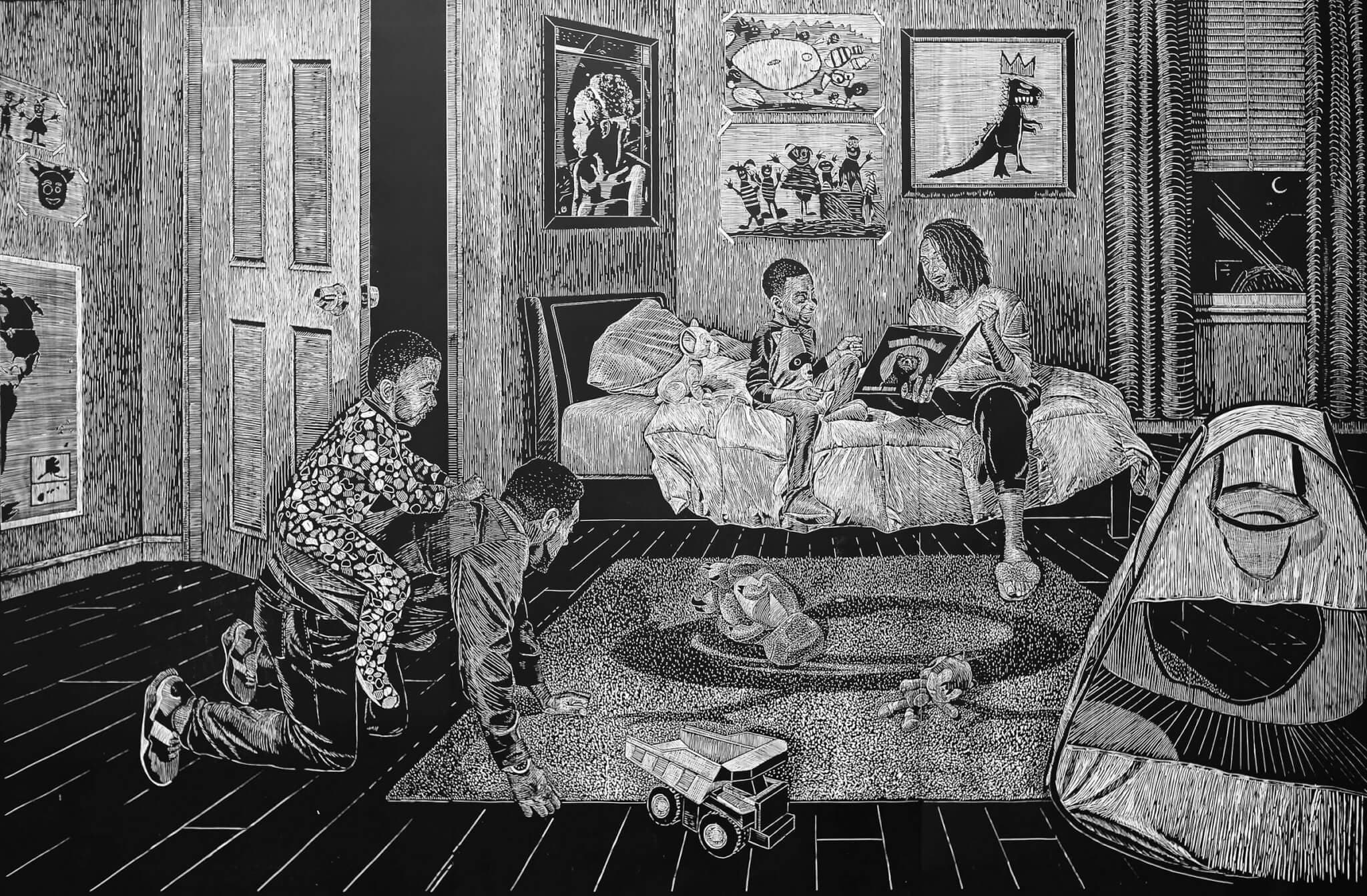I first encountered LaToya M. Hobbs’s work in 2021. It was during a brief visit to Minneapolis to see the group exhibition A Contemporary Black Matriarchal Lineage in Printmaking at the Highpoint Center for Printmaking. There, Hobbs presented Scene 5: The Studio (2020–2021), one of five prints from her larger series Carving Out Time. Taken at first by its scale, at a stunning eight by twelve feet, the work compelled me to step closer, then closer still to study Hobbs’s masterwork of carving—the work’s uninterrupted striations that present an artist self-possessed in her studio and framed by a number of her works in progress. Scene 5 is, by far, the largest woodblock print I have ever seen. As a fellow printmaker, I could fully appreciate, if not quite believe, the rigor that necessitates a work at that scale and of that detail. And as a Black woman in printmaking, I remain enthralled by Hobbs’s unfettered approach to taking up space without sacrificing intimacy.
During the previous summer, I had completed a printmaking project where I was mentored by Stephanie Santana, an artist featured alongside Hobbs in Minneapolis. A Contemporary Black Matriarchal Lineage in Printmaking was co-curated by Delita Martin and Tanekeya Word; the latter is the founder of the organization Black Women of Print (BWoP) of which Hobbs and Santana are both founding members. Created in 2018 and originally inspired by the relationship between Elizabeth Catlett and Margaret Burroughs, BWoP operates as a homeplace, per bell hooks’s term of a site of resistance, to “support and promote the visibility of Black women printmakers.” They serve their members through educational outreach, exhibitions, and the production of portfolios recently held in public collections such as the Getty, The Metropolitan Museum of Art, and the Museum of Fine Arts, Boston. My longing to situate myself within a genealogy of fellow Black women practitioners, to invest in the rigor that our medium demands, led me to Minneapolis then and returns me to Hobbs now.

(left) LaToya M. Hobbs, Scene 4: Bedtime for the Boys, from Carving Out Time, 2020–21. (right) LaToya M. Hobbs, Scene 5: The Studio, from Carving Out Time, 2020–21. Installation view, “LaToya M. Hobbs: It’s Time,” on display March 1–July 21, 2024, at the Harvard Art Museums, Cambridge, MA. Photo © President and Fellows of Harvard College. Courtesy of the Harvard Art Museums.
Three years later, as part of the Harvard Art Museums’ public display, “LaToya M. Hobbs: It’s Time,” all five scenes of Carving Out Time, along with their preparatory sketches, can be appreciated in concert for the first time. I met with Hobbs over Zoom after the show opened. It was a characteristically dreary day in London, while in Baltimore, Hobbs shifted around her studio in her home’s basement, willing her laptop battery to last the length of our call. It was our first time talking, but somehow I felt connected to her; Scene 5 had lingered feverishly since my first encounter with it.
Before arriving at fine art, Hobbs studied biology and was planning on becoming a pediatrician. After three and a half years in the subject, she decided to return to what she enjoyed most, pivoting to complete her BA in studio art at University of Arkansas in Little Rock, her hometown. Hobbs found an affinity for printmaking, particularly drawn to the works of Catlett whose highly stylized compositions Hobbs says “really sealed the deal for me in showing the possibilities of what you could do with printmaking. I also really personally resonated with her imagery.” Buoyed by this affirmation, Hobbs completed her MFA in printmaking at Purdue University. Still, Hobbs is both a painter and a printmaker, and in a number of her works, such as Erin and Anyah with Hydrangeas (2023) and Pinnacle (2024), she flexes her painterly deftness and applies acrylic directly to the wooden panels, complementing her mark making with targeted areas of color. Hobbs has developed a hybrid approach that marries the textural characteristics of printmaking with the preciousness of mediums that resist reproducibility, building a body of work anchored by large-scale depictions of Black women existing just as we are. The artist might have moved on from her medical aspirations, but the principles of care, custodianship, and her attention to the body have remained.
In 2013, Hobbs moved to Baltimore to teach at the Maryland Institute College of Art. Within her first year, she became pregnant with her first son which limited her capacity for being in the studio. Hobbs turned to making small-scale monoprints and woodcuts, and it was only around 2017 when she returned to her process of carving and painting wooden panels that she had developed in grad school. During this time, Hobbs harbored a longing to make larger-scale woodcuts, emboldened by a series of chance encounters with Kerry James Marshall’s Untitled (1998). Marshall’s print is also eight feet tall, but it expands panoramically to cover forty-eight feet. The work made Hobbs resolute, and the desire ultimately led to Carving Out Time: five life-sized woodcuts on cotton paper, each depicting a carefully chosen aspect of a single day.
For her first time making work at this scale, the artist developed a methodology that includes mapping out her days and honing in on routines of interest. In the preparation of the works, Hobbs and her husband, Ariston Jacks, work as collaborators. Jacks, also an artist, helps restage the family’s pivotal routines and then photographs them for Hobbs’s reference as she develops her preparatory sketches. The final stage of the process, Hobbs commands alone. She paints her wooden blocks black and draws the final compositions with a white pencil. At this juncture, Hobbs gets to carving, the part of the process she remains most excited about—her “jam,” as she calls it, with a laugh. The title Carving Out Time sits at a confluence of meanings. It is both a testament to and an acknowledgement of the work of making time for the people and practices we love, and a nod to the medium itself, naming the labor required to birth her prints into life.

LaToya M. Hobbs, American (b. Little Rock, AR 1983), Scene 5: The Studio, from Carving Out Time, 2020–21. Woodcut on cotton paper, 250.8 × 365.8 cm (98 ¾ × 144 in.) Harvard Art Museums/Fogg Museum, Margaret Fisher Fund, 2022.224.5 © LaToya M. Hobbs. Photo by Ariston Jacks. Courtesy of the artist.
Executed during the pandemic lockdown, the series became part of a larger project by Hobbs titled Salt of the Earth, imagined to “personify Black women as salt, thinking about the characteristics of salt as a preserver.” Borrowing from Matthew 5:13–16, Hobbs expands on how “a lot of times, the work we [Black women] do to uphold and preserve things goes unnoticed. We’re expected to work on the behalf of the community, not ourselves.” The meditative carving process that births Hobbs’s familial depictions operates at a distance from both the final prints on view and the synergetic proceedings with her husband that allow her to extract a final composition. It is a realm of working that remains uniquely her own. “That’s one of the reasons why I like relief; you don’t need anybody to help you do it,” she reflects. In this vein, Scene 5 comes to mind again. Taking the time to nurture her artmaking is Hobbs’s act of self-compassion. For Hobbs, the process of carving is “symbolic of excavating or taking away or shedding layers. As Black women, we have to do that a lot: take away the ideas that people have about us. It’s a constant, when you see stuff in the media or how we’re portrayed in certain ways, you’re constantly having to say, no, that’s not me.”
Carving becomes a modality through which Hobbs can reclaim her image as well as that of her family, and resist forces that conspire to minimize her self-actualization. In making her mark, Hobbs pays tribute to Black women’s interiority. The attentiveness of the work lies not just on the surface: in the content depicted, but deep within the grooves of Hobbs’s making.

LaToya M. Hobbs, American (b. Little Rock, AR1983), Scene 4: Bedtime for the Boys, from Carving Out Time, 2020–21. Woodcut on cotton paper, 250.8 × 365.8 cm (98 ¾ × 144 in.) Harvard Art Museums/Fogg Museum, Margaret Fisher Fund, 2022.224.4 © LaToya M. Hobbs. Photo by Ariston Jacks. Courtesy of the artist.
“In thinking about myself as a mother, what the matrix is, is something that births other things in its likeness,” Hobbs says, drawing on the Latin origin of the word womb. In printmaking, the matrix is the surface from which an image is transferred, usually onto paper, and in Hobbs’s case it is her carved wooden block. Traditionally, printmaking has placed higher value on the production of editioned works than on the matrix as a viable art object in its own right. Oftentimes, the matrix is destroyed, sealed, or otherwise permanently altered to prevent reproduction after a limited edition is completed. Hobbs’s practice troubles this convention, channeling the latent potency of the matrix to present them as artworks in and of themselves. Prior to her display at Harvard, Hobbs first exhibited the wooden matrices from which the prints are pulled in “All Due Respect,” a group exhibition featuring Hobbs alongside Lauren Frances Adams, Mequitta Ahuja, and Cindy Cheng at the Baltimore Museum of Art in 2021. In fact, Hobbs originally made the blocks without any intention to print them. “I’m not as excited about making editions as I am about carving the block,” she offers. It was only after being encouraged by her husband that she printed the works on paper. For Hobbs, the wooden block remains the primary work, and the prints on paper second to them. In her view, “the matrix is the art object.”
In Carving Out Time, Hobbs reproduces foundational works by Elizabeth Catlett, Margaret Burroughs, Valerie Maynard, and Alma Thomas in the backgrounds of her domestic spaces. Gracious in her citations, Hobbs’s work incises a lineage of Black women artists, carving out a space in art history replete with contemporary significance. Printmaking might be defined by a primary gesture (i.e. an incision, etch, or carving) and then the consequence of that gesture that remains visible. Latoya M. Hobbs’s practice has long been celebrating these gestures, and her show at Harvard is just a recent example of her endearing commitment to the work of Black women’s hands. Through her practice, her teaching, and her involvement with Black Women of Print, the artist pays careful attention to the labor of being an artist, wife, parent, and person. This labor is then restaged through carving, as she traces herself in perpetuity, reaffirming the often invisible sacrifice and love in action that daily life requires. The amount of detail is a result of that love; the love necessitates the detail, and this doesn’t seem to be changing any time soon.
“LaToya M. Hobbs: It’s Time” is on view at the Special Exhibitions Gallery, Harvard Art Museums through July 21, 2024.









